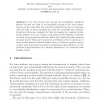Free Online Productivity Tools
i2Speak
i2Symbol
i2OCR
iTex2Img
iWeb2Print
iWeb2Shot
i2Type
iPdf2Split
iPdf2Merge
i2Bopomofo
i2Arabic
i2Style
i2Image
i2PDF
iLatex2Rtf
Sci2ools
100
click to vote
IPMU
2010
Springer
2010
Springer
Approximation of Data by Decomposable Belief Models
It is well known that among all probabilistic graphical Markov models the class of decomposable models is the most advantageous in the sense that the respective distributions can be expressed with the help of their marginals and that the most efficient computational procedures are designed for their processing (for example professional software does not perform computations with Bayesian networks but with decomposable models into which the original Bayesian network is transformed). This paper introduces a definition of the counterpart of these models within Dempster-Shafer theory of evidence, makes a survey of their most important properties and illustrates their efficiency on the problem of approximation of a “sample distribution” for a data file with missing values.
Bayesian Network | Decomposable Models | Graphical Markov Models | Information Technology | IPMU 2010 |
Related Content
| Added | 28 Jan 2011 |
| Updated | 28 Jan 2011 |
| Type | Journal |
| Year | 2010 |
| Where | IPMU |
| Authors | Radim Jirousek |
Comments (0)

